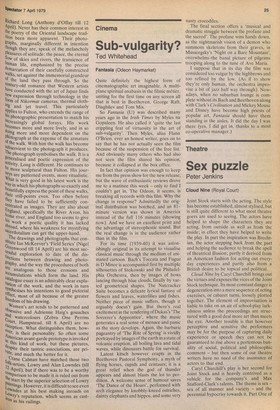Sub-vulgarity?
Ted Whitehead
Fantasia (Odeon Haymarket) Quite definitely the highest form of cinematographic art imaginable. A multiplane spiritual anabasis in the filmic métier, uniting for the first time on any screen all that is best in Beethoven, George Raft, Diaghilev and Tom Mix.
So Fantasia (U) was described many years ago in the Irish Times by Myles na Gopaleen. He also called it 'quite the last crippling feat of virtuosity in the art of sub-vulgarity'. Then Myles, alias Flann O'Brien, ever an honest writer, goes on to say that he has not actually seen the film because of the suspension of the free list. And obviously many others who had also not seen the film shared his opinion, because it collapsed at the box office.
In fact that opinion was enough to keep me from the press show for the new release, but the wave of enthusiastic reviews drove me to a matinee this week — only to find I couldn't get in. The Odeon, it seems, is breaking all records with this film. Why the change in response? Admittedly the original distribution was botched, and an 81minute version was shown in America instead of the full 116 minutes (showing now). And we have an excellent print and the advantage of stereophonic sound. But the real change is in the audience rather than in the film.
For its time (1939-40) it was astonishingly original in its attempt to visualise classical music through the medium of animated cartoon. Bach's Toccata and Fugue in D Minor is accompanied first by multiple silhouettes of Stokowski and the Philadelphia Orchestra, then by images of bows lancing through blue clouds, finally by varied geometrical shapes. The Nutcracker Suite becomes a delicate lyrical fantasy of flowers and leaves, waterlilies and fishes. Neither piece of music suffers, though it arguably doesn't gain. But there's real excitement in the rendering of Dukas's 'The Sorcerer's Apprentice', where the music generates a real sense of menace and panic as the story develops. Again, the barbaric pageantry of 'The Rite of Spring' is vividly portrayed by images of the earth in a state of volcanic eruption, all boiling lava and tidal waves, while dinosaurs battle for survival.
Latent kitsch however erupts in the Beethoven Pastoral Symphony, a myth of flying horses, cupids and centaurs; it is a great relief when the god of thunder appears and almost blasts the lot to perdition. A welcome sense of humour saves 'The Dance of the Hours', performed with arch elegance by knobbly-kneed ostriches, dainty elephants and hippos, and some very nasty crocodiles.
The final section offers a 'musical and dramatic struggle between the profane and the sacred'. The profane wins hands down, as the nightmarish vision of a demon who summons skeletons from their graves, in Mussorgsky's 'Night on a Bare Mountain', overwhelms-the banal picture of pilgrims trooping along to the tune of Ave Maria.
I suppose that in its day the film was considered too vulgar by the highbrows and too refined by the low. (As if to show they're only human, the orchestra improvise a bit of jazz half way through). Nowadays, when no suburban lounge is complete without its Bach and Beethoven along with Clark's Civilisation and Mickey Mouse and Disney have become high priests of popular art, Fantasia should have them standing in the aisles. It did the day I was there (yes, I did get in, thanks to a most co-operative manager.)


































 Previous page
Previous page